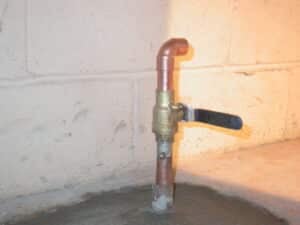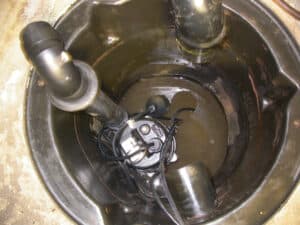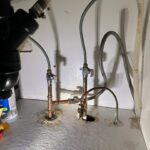Natural disasters are a threat to your plumbing system.
Recent research has shown that between the years 1900 to 2016 the United States has experienced a lot of natural disasters inclusive of 24 heat waves.
As a matter of fact, the data shows that aside from China, the United States is the country with the most natural disasters.
Furthermore, there have been over 106 cyclones, 40 earthquakes, and 2 tsunamis from 1900 to 2016 alone, which affected over 13.5 million people.
Crazy right? Well, that's not all, in 2015; the United States recorded 22 natural disasters being ousted only by China.
By now you should understand the importance of knowing exactly what to do in the event of an evacuation due to natural disasters. It's extremely vital!
The data revealed that 13.5 million people have been directly affected by natural disasters but how many of them knew the right steps to take to protect their plumbing and ultimately their home before being evacuated?
The effects of unprotected plumbing can be disastrous to any home when disaster strikes.
So what do you do when you are a certain disaster is on its way? Below are a few steps that you'll need to follow to ensure you adequately preserve your home with proper plumbing protection.
Basic Protection of Your Plumbing System
Studies have shown that tornadoes are accompanied by exempt destructive winds moving at speeds of over 289 MPH and what's more? A tornado's leaves a messy trail of destruction measuring up 50 miles long and 1 mile in width!
Can you imagine the wreckage? Regardless, of the damage, you can still save your home by preparing it before evacuation and the first thing you need to do is:
1. Ensure Your Water Heater is Safely Hooked to the Wall
This cannot be overemphasized, as the damage a loosed water heater can cause to your home is immense. Before you leave your home due to evacuation ensure that it is properly strapped to the wall. One wrong fall can initiate a domino effect of problems.
It can easily fall off during a storm and break gas lines or cause other damages that could become irreparable.
So how do you safely strap your water heater to the wall? Well first things first, you need to check for the plumber's tape.
Keep in mind that prior to the Loma Prieta and Northridge earthquakes in 1989 and 1994 respectively, only 1 single strap of plumber tape was recommended by experts, however, now more is recommended due to numerous water heaters bursting as a result of single strapping.
So, what is acceptable now is a heavy-metal gauge strapping instead of a regular plumbing strap. Next, you need to secure both the top and bottom of your heater rather than just the top or bottom as this won't pull through.
Then ensure that you replace all metal and copper piping with flexible water connectors or natural gas pipes. These will prevent a disastrous outcome in the event of breakage.
2. Switch off Your Main Water Valve
After your water flows through your cities valves it gets to what is termed as the main water valve. This is a very important valve that you need to know its exact location before any form of disaster occurs.
Why? Well, the main water valve is responsible for allowing the full flow of water into your home when turned on and when it is turned off, usually in anti-clockwise motion it shuts off the complete water flow into your home.
You might be wondering why shutting off water is essential during an evacuation. It is highly vital because a simple pipe break can leave your house flooded, which will eventually ruin things left over in your home.
Now, your main water valve is usually located either in your basement or on an outside wall in a utility area of your home, so simply turn it off by turning in an anti-clockwise direction.
Ensure you find the location before you have to hurriedly leave due to an incoming natural disaster; otherwise, it might be quite difficult to locate it when in panic mode.
There are two types of designs for the main valve:
i). Gate Valve: The gate valve has one of the most durable valve design there is, however, they usually become very stiff and extremely difficult to move if they haven't been touched for some years.
Hence, it's best you find its location as it'll be a lot easier getting a tool to move it when you're in a peaceful state of mind that when a natural disaster is looming over your head.
b). Ball Valve: If your home uses a plastic or copper pipe then you most likely have full-blown ball valve. In order to know when a ball valve is open or close you need to check its placement. For instance, if the ball valve handle is directly aligned with the pipe then it's open.

You have to keep in mind that the main valve is a major way to prevent a lot of plumbing disasters, so you need to ensure that you know it's a location like the back of your hand. So in the event of an evacuation, you can easily turn it off without any complications.
Also, if you are using a gate valve and haven't touched it for years, you need to keep a plier around you that's easily reachable, as you may have to use it to change its position in order to shut it off in the event of a hurried evacuation.
Furthermore, whenever you adjust the position of the valve, whether open or close, it may begin to leak a bit. All you need to do to stop it is tighten the nut, as the stem of the valve is held in place by a nut called the packing nut.
3. Remove Debris From Your Drains and Sump Pump

However, they can easily get clogged up if proper maintenance is not carried out on them before an evacuation takes place.
Hence, you have to ensure they your Sump Pump has all debris and clogs efficiently removed from it and serviced adequately before leaving.
Now, you should also make sure that your home gutters are a properly cleared of debris as they can easily get clogged up with grass clippings and leaves, so, to ensure that your sewage system works efficiently clear it out completely.
a. How to Clean Out Your Sump Pump
In order to efficiently clean out your Sump Pump, you're going to need a few tools such as plastic sheets, plastic scraper, container, dry or wet shop vac, and a garden hose.
The next step is to turn off everything your Sump Pump is linked too. All you need to do is turn off the electricity being supplied to it, by either switching off the circuit breaker connected to the Sump Pump or simply turning off the electric connection of the Sump Pump itself.
Second, you need to locate the discharge pipe your Sump Pump is connected too and disconnect it.
After doing all of that, it's now time to clean it off. So simply wrap up your Sump Pump with a plastic wrapper. This is to prevent debris, dirt, and sludge from spilling all over your house as most of its dirt would be extremely dangerous to your health.
Once you've done that and your Sump Pump is outside, take off the plastic wrap and connect your garden hose with water and begin to wash off the sludge and dirt from off the pump.
In some instances, you'll have to deal with caked dirt on your pump, especially if you haven't cleaned it out for a while. Well, no worries that's what the plastic scraper is for.
Simply scrape off all the caked dirt and slime from off the pump completely and rinse it again with water.
For the final cleaning step, you'll have to remove standing water from the Sump pit. To do this effectively, you would need to use a way or dry vac.
Conclusion
If you're a homeowner, renter or business office owner you need to have a well thought its plans in place to ensure that you effectively secure the plumbing of your building or home.
And this goes beyond just your home. The life of your loved ones and property is also at stake if these preventive measures are not taking to protect your plumbing.
Furthermore, make sure that your drains and Sump Pumps are completely cleared out before evacuation.
Follow these tips in order to efficiently protect your home plumbing system without struggles.

